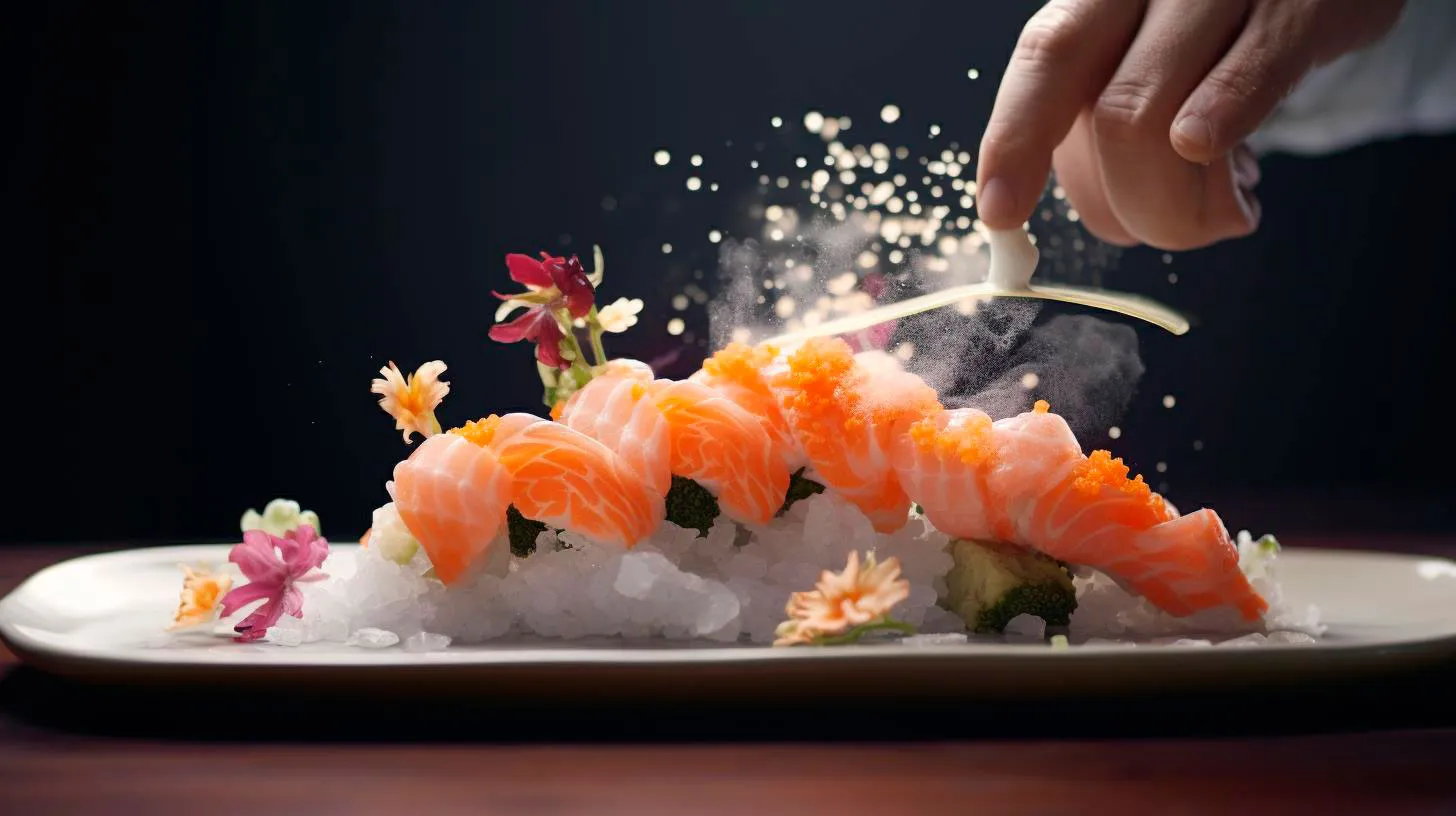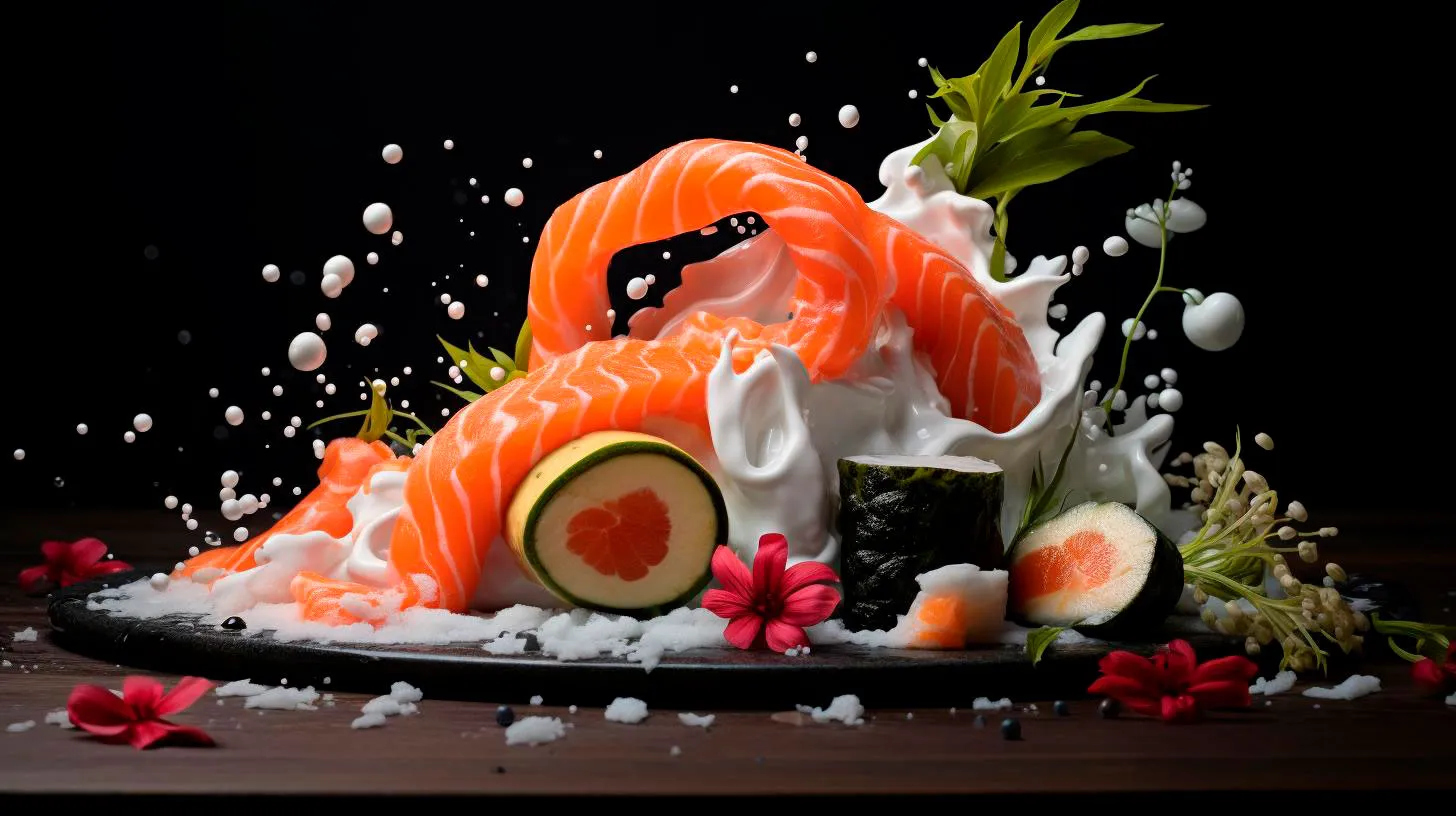Sushi Science: Teach Your Little Ones About the Art of Sushi
Not only will it expand their taste buds, but it can also be a fun and educational activity for the whole family. So, let’s dive into the sushi science and learn how to get your kids excited about this delightful culinary experience!
Benefits of Teaching Kids About Sushi
Before we delve into the intricacies of sushi making, let’s take a look at why exposing children to this Japanese delicacy is a great idea:
- Cultural Awareness: Introducing sushi to your little ones is an opportunity to immerse them in Japanese culture. They can learn about the different ingredients, presentation techniques, and the artistry involved in sushi-making.
- Nutritional Value: Sushi is not only delicious but also a healthy choice for kids. It’s packed with essential nutrients, lean protein, heart-healthy fats, and vitamins. Educating your children about the benefits of different ingredients fosters a healthy eating habit.
- Motor Skills Development: Preparing sushi rolls requires fine motor skills, enhancing hand-eye coordination in children. From spreading rice to rolling the sushi, these activities help refine their dexterity.
- Introduction to New Flavors: Sushi offers an array of flavors and textures that might be new to your children. Encouraging them to experiment with various toppings and fillings can broaden their palate and make them more open to trying new foods in the future.
Getting Started: Basic Sushi Making
Teaching your little ones about sushi doesn’t have to be intimidating. Let’s break it down into simple steps:
1. Introduction to Ingredients
Begin by explaining the various components of sushi. Show your children the different types of fish, vegetables, and other fillings commonly used. Emphasize the importance of fresh ingredients and how they contribute to the overall taste and quality of the dish.
2. Sushi Rice Preparation
Show your kids how to cook and season sushi rice properly. Explain the significance of the right texture and flavor of the rice in complementing the ingredients.
3. Sushi Rolling Techniques
Introduce your children to the art of sushi rolling. Demonstrate how to spread the rice evenly on the nori (seaweed) sheet and add fillings. Involve them in rolling the sushi using bamboo mats, teaching them this hands-on technique.
4. Creative Filling Choices
Encourage your little ones to get creative with their sushi fillings. Provide a variety of options such as cucumber, avocado, cooked shrimp, crab sticks, or even their favorite fruits. This allows them to personalize their sushi rolls and discover unique flavor combinations.
5. Presentation and Garnishing
Explain the importance of presentation when it comes to sushi. Teach your children how to cut the rolls into bite-sized pieces and garnish them with sauces, sesame seeds, or colorful toppings. This adds a visual appeal to their creations, making them even more delectable.
Bringing Science into Sushi
There’s science behind every plate of sushi! You can make the experience even more intriguing by exploring these fascinating scientific aspects:
- Chemistry of Rice: Discuss how rice transitions from a firm, opaque grain to a sticky and translucent texture. Explain the role of starch and the process of gelatinization during rice cooking.
- Physics of Rolling: Introduce concepts like surface tension and adhesion to highlight how sushi rolls stay intact. Explore the physics behind applying pressure evenly while rolling to avoid any mishaps.
- Biology of Seafood: Dive into the marine world and teach your kids about the different types of fish used in sushi. Explore the concept of sustainable fishing, discussing the impact of overfishing on marine ecosystems.
Key Takeaways
When teaching your kids about sushi, keep these essential points in mind:
- Cultivate cultural awareness and appreciation for Japanese cuisine.
- Highlight the nutritional benefits of sushi for a healthy lifestyle.
- Promote the development of fine motor skills through the art of sushi making.
- Encourage experimentation with flavors and textures.
- Integrate scientific concepts related to sushi preparation.
By engaging your children in the art of sushi making, you foster a sense of curiosity, expand their culinary horizons, and create wonderful memories together. So put on your aprons, grab the chopsticks, and embark on a sushi adventure with your little ones today!
Sushi Party Planning: A Memorable Culinary Adventure for Children
Why Choose Sushi for a Kids’ Party?
Sushi is not only delicious but also offers several benefits that make it an ideal choice for your child’s party:
- Variety: Sushi provides a wide array of options to cater to various tastes and dietary preferences. From vegetarian rolls to fresh fish options, there is something for everyone.
- Nutritional Value: Sushi is a healthy meal choice as it contains essential nutrients, vitamins, and omega-3 fatty acids.
- Hands-on experience: Sushi allows kids to get hands-on and creative while preparing their own rolls, making the party interactive and engaging.
- Cultural Exploration: Introducing children to sushi not only exposes them to new flavors but also helps them appreciate diverse cultures.
Planning the Perfect Sushi Party
1. Guest List and Invitations
Start by creating a guest list of your child’s friends who will attend the sushi party. Craft personalized invitations with sushi-themed designs, enticing them to join the culinary adventure.
2. Venue and Decorations
Choose an appropriate venue, which could be your home or a sushi restaurant with a dedicated party area. Decorate the venue with Japanese-inspired decorations, such as cherry blossom cutouts, origami paper art, or colorful paper lanterns.
3. Sushi Ingredients and Supplies
Ensure you have fresh and high-quality ingredients such as sushi rice, nori (seaweed sheets), fresh fish or vegetables, soy sauce, wasabi, and pickled ginger. Stock up on sushi rolling mats, knives, and plates for each participant.
4. Sushi Rolling Station
Set up a sushi rolling station where children can assemble their own rolls. Provide step-by-step instructions or engage a sushi chef to demonstrate the rolling techniques. Encourage the kids to experiment with various ingredients and create their unique flavor combinations.
5. Sushi Tasting and Accompaniments
After the rolls are prepared, create a sushi tasting station where children can sample their creations. Offer a selection of accompaniments such as miso soup, edamame, and tempura for a complete Japanese dining experience.
6. Sushi Party Games and Activities
Add some excitement to the party with sushi-themed games and activities. Here are a few ideas:
- Guess the Sushi: Blindfold the participants and challenge them to identify different sushi rolls by taste.
- Sushi Chef Contest: Conduct a sushi chef competition, where children can showcase their creativity by designing the most innovative rolls.
- Origami Workshop: Teach the children the art of origami, allowing them to make their own sushi-themed paper creations.
7. Party Favors and Takeaways
Ensure your young foodies leave with lasting memories. Personalized chopsticks, sushi-shaped erasers, or mini sushi kits can make wonderful party favors that continue the sushi journey even after the event.
Key Takeaways
- A sushi party allows children to explore new flavors, embrace culinary creativity, and appreciate diverse cultures.
- Sushi provides a variety of options to cater to different tastes and dietary preferences.
- Engage the children in hands-on sushi rolling activities and encourage them to experiment with various ingredients.
- Offer sushi-themed decorations, games, and activities to make the party more enjoyable and memorable.
- Provide party favors that extend the sushi experience beyond the event.
By planning a sushi party, you are not only organizing a memorable culinary adventure for children, but also fostering their appreciation for different foods and cultures. With hands-on activities, delicious flavors, and a dash of creativity, your sushi party is sure to be an unforgettable experience for all your little guests!
Sushi-Making Crafts: A Fun and Delicious Activity for Kids
In this article, we’ll explore the wonders of sushi-making crafts, their benefits, and a step-by-step guide on how to create these delightful treats.
The Benefits of Sushi-Making Crafts for Kids
Engaging in sushi-making crafts not only creates lasting memories but also offers numerous advantages for children, both academically and personally. Let’s take a look at some of the benefits:
- Promotes Creativity: Sushi-making crafts allow children to explore their creative side by experimenting with different ingredients and designs. They can design their sushi rolls with colorful vegetables and fruits, making each creation a unique masterpiece.
- Enhances Fine Motor Skills: The delicate art of crafting sushi requires precision and attention to detail. Rolling and cutting sushi rolls help children improve their fine motor skills, hand-eye coordination, and manual dexterity.
- Encourages Healthy Eating: By involving kids in sushi-making crafts, we introduce them to a variety of fresh and nutritious ingredients. This activity can inspire them to explore new flavors and develop a love for healthy eating habits.
- Builds Cultural Awareness: Sushi is a significant part of Japanese culture, and introducing it to kids through crafts can help them learn and appreciate different traditions and cuisines.
- Fosters Bonding and Collaboration: Sushi-making crafts are an excellent opportunity for families and friends to come together, work as a team, and enjoy a delicious meal they created together. It strengthens relationships and creates cherished memories.
How to Create Sushi-Making Crafts with Kids
Step 1: Gather the Ingredients and Supplies
Before diving into the world of sushi-making crafts, gather the essentials:
- Sushi rice
- Nori seaweed sheets
- Sliced vegetables and fruits (cucumber, avocado, carrot, mango)
- Protein options (cooked shrimp, crab, grilled chicken, tofu)
- Soy sauce, wasabi, and ginger for serving
- Bamboo sushi rolling mat
- Knife for cutting
Step 2: Prepare the Sushi Rice
Cook the sushi rice according to package instructions. Once cooked, let it cool to room temperature before using it for sushi rolls.
Step 3: Assemble the Sushi Rolls
Place a rectangular sushi rolling mat on a clean surface and cover it with a sheet of nori seaweed. Spread a thin layer of sushi rice evenly over the nori, leaving a small border at the top.
Add your chosen ingredients in a neat line across the center of the rice. This is where kids can get creative and choose their favorite combinations.
Using the sushi mat, carefully roll the ingredients, applying gentle pressure to create a tight and compact roll.
Step 4: Slice and Serve
With a sharp knife, slice the sushi roll into bite-sized pieces. Arrange the sushi rolls on a plate and serve with soy sauce, wasabi, and ginger on the side.
Key Takeaways
Sushi-making crafts are not only a fun activity for kids but also a valuable learning experience. By engaging in these delightful crafts, children can nurture their creativity, improve their fine motor skills, embrace healthy eating habits, and develop a deeper appreciation for various cultures.
So why not gather your little ones for a memorable sushi-making adventure? Get ready for creativity to flourish, taste buds to be delighted, and hearts to be filled with joy!
Sushi for Kids: Exploring New Flavors and Ingredients
With its wide range of flavors and ingredients, sushi offers a unique opportunity for children to explore new tastes and develop a love for diverse cuisines.
Introducing children to sushi at an early age can have several benefits. Not only does it encourage them to expand their palate, but it also promotes a balanced and nutritious diet. By incorporating sushi into their meals, kids can enjoy a variety of vitamins, minerals, and essential nutrients from ingredients such as fish, vegetables, and seaweed.
The Benefits of Sushi for Kids
Let’s take a closer look at some of the key advantages of introducing sushi to your child’s diet:
- Varied Flavors: Sushi provides a unique range of flavors for kids to explore, from the subtle taste of fresh fish to the crunchiness of vegetables. Exposing children to different flavors at an early age can help in shaping their taste preferences and make them more adventurous eaters.
- Nutritional Value: Sushi is packed with nutrients that are beneficial for a child’s growth and development. Fish, a primary ingredient in sushi, is an excellent source of protein, omega-3 fatty acids, and essential minerals like iodine and calcium. Vegetables and seaweed used in sushi rolls add fiber, vitamins, and antioxidants to the meal.
- Healthy Snacking Option: Kids often crave snacks that are packed with unhealthy ingredients. Sushi can be an excellent alternative to processed snacks, offering a healthier option that satisfies cravings without compromising nutrition.
- Enhances Motor Skills: Sushi eating is a hands-on experience that helps improve fine motor skills in children. The process of using chopsticks to grasp sushi rolls promotes hand-eye coordination and dexterity.
Key Takeaways for Parents
As parents, it is essential to foster an environment where children can explore new flavors and develop healthy eating habits. When it comes to sushi, here are some key takeaways to consider:
1. Start with Simple Rolls:
Begin by introducing your child to simple sushi rolls with familiar ingredients like cucumber or avocado. Gradually, you can introduce them to more complex flavors such as cooked fish or tempura.
2. Involve Kids in the Preparation:
Engaging children in the sushi-making process not only makes them more excited about trying new foods but also teaches them about the importance of fresh ingredients and food preparation.
3. Educate on the Importance of Seafood Sustainability:
Teach your child about the importance of choosing sustainably sourced seafood. Explain how their choices can help protect the ocean’s ecosystems and ensure a healthy future for marine life.
4. Encourage Open-mindedness:
Instill a sense of adventure in your child’s eating habits by encouraging them to try new flavors and ingredients. Incorporate sushi into family meals, making it a fun and inclusive experience for everyone.
Final Thoughts
Sushi for kids has evolved beyond being a niche concept; it has become a delightful way to introduce children to new flavors and ingredients. By offering a healthy combination of taste, nutrition, and interactive eating experience, sushi can be a gateway to a world of diverse cuisines for young ones to explore. So, why wait? Start expanding your child’s culinary horizons with a delightful sushi adventure today!



